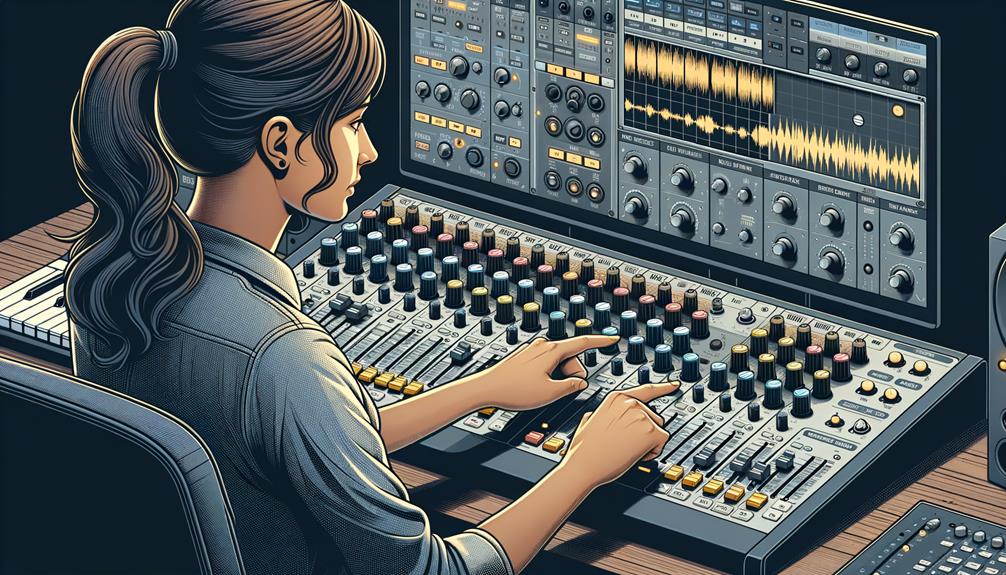Subtotal: £149.00
Ever listened to a song and felt like the sound was just not fully coming together? Adding reverb in FL Studio can be the missing piece to give your tracks that professional polish.
But where do you start? How do you navigate the myriad of options to find the right reverb for your sound?
In this discussion, we’ll walk you through the step-by-step process of adding reverb in FL Studio, from understanding different reverb types to using reverb as an artistic tool in your music production.
By the end, you’ll have the knowledge and confidence to elevate your tracks with the perfect touch of reverb.
Key Takeaways
- There are different types of reverbs available in FL Studio, such as plate, spring, hall, room, and convolution reverbs.
- Setting up reverb sends in FL Studio involves creating a new track, adjusting the send level, and using the Reverb plugin.
- Experimenting with reverb parameters like pre-delay, decay, and diffusion can create various reverb textures.
- Adjusting reverb parameters like decay time, wet/dry mix, and pre-delay can help achieve depth and space in the reverb effect.
Understanding Different Reverb Types
When exploring different reverb types, you can begin by understanding the distinctive characteristics and effects of plate, spring, hall, room, and convolution reverbs.
Plate reverbs simulate the sound of a vibrating metal plate, creating a shimmering effect. They’re known for their smooth and lush characteristics, adding a sense of depth and space to audio.
Spring reverbs, on the other hand, emulate the sound of audio vibrating through a set of springs, producing a unique, boingy effect. These reverbs are often characterized by their bright and lively sound, making them popular in creating vintage and retro tones.
Hall reverbs replicate the reverberation of sound in a large, open space, such as a concert hall, adding depth and grandeur to the audio. They can create a sense of spaciousness and envelopment, making them ideal for creating an expansive and immersive sound.
Room reverbs mimic the sound of a smaller enclosed space, providing a more intimate and natural reverberation. These reverbs can add warmth and realism to audio, making them suitable for creating a sense of closeness and proximity.
Setting Up Reverb Sends in FL Studio
After understanding the distinctive characteristics and effects of different reverb types in FL Studio, the next step is to set up reverb sends to manipulate and enhance the audio. By creating a new track and assigning it a fader number, such as 10, you can establish a reverb send. Access the mixer and locate the track fader to adjust the send level for the reverb effect. Then, find the Reverb plugin within the mixer and send the desired amount of signal from the track to the reverb effect. Adjust the reverb effect settings within the plugin to tailor the sound to your preference. Experiment with different track levels and reverb settings to achieve the desired reverb effect.
| Reverb Techniques | Reverb Plugins | Reverb Routing |
|---|---|---|
| Experiment with pre-delay, decay, and diffusion settings to create different reverb textures. | Utilize third-party reverb plugins for a wider range of reverb options and more advanced controls. | Utilize auxiliary tracks and sends to route multiple audio sources to a single reverb effect, creating a cohesive space. |
Adjusting Reverb Parameters for Depth and Space


To enhance the depth and spaciousness of your audio, adjust the reverb parameters to control the decay time, wet/dry mix, pre-delay, and filters while exploring the room size parameter for simulating different acoustic environments.
By increasing the reverb decay time, you can create a longer, more realistic reverb tail, adding a sense of spaciousness to your sound.
Experimenting with the wet/dry mix allows you to precisely control the depth of the reverb effect, ensuring it complements the original audio without overwhelming it.
Additionally, adjusting the pre-delay parameter can simulate distance and depth, making the reverb feel further away from the sound source.
Utilizing high-pass and low-pass filters helps shape the reverb’s frequency response, further enhancing its spatial positioning within the mix.
Understanding reverb decay time is crucial for creating realistic reverbs, as it directly impacts the perceived size of the virtual space.
Continuously experimenting with reverb presets and parameters will allow you to fine-tune the depth and spaciousness of your audio, achieving the desired spatial characteristics for your mix.
Using Reverb as an Artistic Tool in FL Studio
Experiment with a variety of reverb settings in FL Studio to creatively craft a sense of space and depth within your mix. Creating unique textures is a key aspect of using reverb as an artistic tool.
Try combining multiple reverbs to add complexity and richness to your sound. Experiment with reverb modulation to introduce movement and dynamism, adding an extra layer of creativity to your music.
Additionally, consider utilizing automation to modulate reverb parameters over time, allowing for evolving and dynamic sonic textures. This approach can help you achieve a more innovative and captivating sound, setting your music apart from the rest.
Tips for Mixing and Automating Reverb in FL Studio


As you continue to shape the spatial and textural elements of your mix in FL Studio, a crucial aspect to consider is the strategic implementation of reverb mixing and automation techniques.
Utilizing send tracks for reverb allows for greater control over the effect, enabling you to blend the dry and wet signals effectively.
Experiment with reverb automation techniques by modulating parameters like wet/dry mix, decay time, and pre-delay, to create dynamic and evolving reverb effects that add depth and movement to your mix.
Adjusting the pre-delay setting is essential for creating a sense of space and clarity, particularly for vocals and lead instruments.
Employ reverb EQ techniques to sculpt the frequency content of the reverb, ensuring it integrates seamlessly into the mix without causing muddiness.
Additionally, consider using reverb in parallel to blend the dry and heavily reverberated signals, allowing for a more controlled and impactful reverb effect.
These advanced techniques will elevate your mixing skills, providing innovative ways to craft immersive and captivating sonic landscapes in FL Studio.
Frequently Asked Questions
How Do I Add Reverb in FL Studio?
To add reverb in FL Studio, click on the desired area, choose the track and fader, and locate the Reverb effect. Adjust parameters to create depth, experiment with settings, and save custom presets. Explore other effects and advanced techniques for innovative sound.
How Do You Add Reverb Effect?
To add reverb effect, explore reverb plugins and customize reverb settings. Experiment with various reverb techniques to shape the sound. Utilize automation to control the intensity of effects over time. FL Studio offers innovative ways for sound manipulation.
How Do I Add Reverb Automation in FL Studio?
To add reverb automation in FL Studio, first, delve into reverb techniques. Explore modifying reverb parameters to shape your sound. Experiment with various reverb plugins to find the perfect fit for your track’s atmosphere.
How Do I Open Fruity Reverb in FL Studio?
To open Fruity Reverb in FL Studio, click on the track and locate the Reverb settings. Then, access the Fruity reverb interface to fine-tune the mixing reverb techniques. Experiment with different options to customize your sound.
Conclusion
In conclusion, adding reverb in FL Studio is a straightforward process that involves:
- Setting up the track and fader options
- Locating and adding the Reverb 2 plugin
- Customizing the parameters to achieve the desired sound
Understanding the different types of reverb, adjusting parameters for depth and space, and using reverb as an artistic tool can enhance the overall mix in FL Studio.
Experimenting with these techniques and automating reverb can lead to a more dynamic and professional sound.






